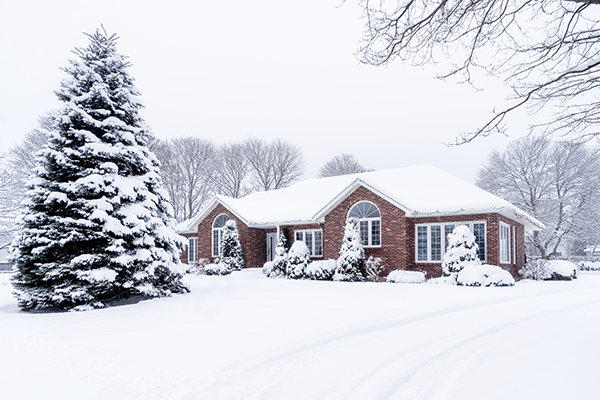Best Materials for Minnesota Roofs
Author: Dan Stout | March 4, 2024
There are few states as beautiful as Minnesota. From Minnehaha Falls to the snow-covered slopes of Buena Vista, the Land of 10,000 Lakes displays some of the best scenery nature has to offer. But nature can be fierce as well as beautiful, and Minnesota roof-building practices have to take both the good and bad into account.

Minnesotan roofs must withstand dramatic swings in seasonal temperature. Summer thunderstorms bring hail and heavy winds, while winter's fierce cold and snowfall are punctuated by sudden thaws that can leave ice dams and leaks in their wake.
Just like Minnesotans have to consider the weather before dressing to go outside, it's on residential contractors to choose the right layers of protection for a Minnesota roof.
Snowy Winters
It's no surprise that Minnesota sees high levels of snowfall. In 2022-2023, the National Weather Service reports that both Duluth and Brainerd had record levels of snowfall, seeing 140.1 and 89.3 inches, respectively. Snow piling up on a roof creates potential leaks and ice dams, while also posing a risk of roof collapse under all that extra weight.
Metal roofs are a popular option for homeowners worried about snow accumulation. Snow slips off the slick metal surfaces, especially if the roof has southern exposure. A metal roof may eliminate the need to manually remove snow buildup. Slate is also slick enough to shed snow easily, though the heavier weight of slate does make lower-slope roofs more vulnerable to weight overload.
In fact, both these materials are so efficient at shedding snow that it's a good idea to install snow guards to prevent a massive avalanche from a slate or metal roof.
Summer Storms Bring Wind and Hail
In Minnesota, summer roof damage is often caused by strong winds and hail. The StarTribune reports a significant spike in windy days, when the wind speed averages more than 20 mph, and some of the most destructive windstorms in Minnesota history occurred in 2022, with wind gusts up to 94 mph.
Taking this into account, Minnesota code requires asphalt shingles to be "designed for a 115 mph maximum ultimate design wind speed. This wind speed equates to a maximum basic wind speed of 90 mph."
Another hazard for a typical Minnesota roof is hail damage. Minnesotans suffered through "golf ball-sized hail" as recently as August 2023, when hailstones around 1.6 inches rained down destruction.
For hail resistance, look for an Underwriters Laboratories (UL) or FM Approvals (FM) rating. These two organizations test impacts on flexible or rigid materials, respectively. Their tests vary slightly in methodology, but both strive to test the roofing material's resistance to impact. They both divide roofing materials into four classes:
- Class 1 can withstand impacts from 1.25-inch diameter hail (or other objects).
- Class 2 can withstand impacts from 1.5-inch diameter hail.
- Class 3 can withstand impacts from 1.75-inch diameter hail.
- Class 4 can withstand impacts from 2-inch diameter hail.
Every Part of a Roof Matters
It's not just the roof itself to consider! The rest of the structure, from underlayment to fasteners, should be selected to withstand the environment.
An essential element of any Minnesota roof is an ice and water shield. These barriers lie under the bottom of the roof, invisible from the street, guarding against wind-driven rain and creeping ice dams.
Ice and water shields are particularly useful against ice dams. When snow covering a roof begins to melt, ice dams are formed when the runoff hits the colder air at the edge of the roof and refreezes. This cycle continues, with the ice forming a wall that gradually pushes back into the roof. However, an ice and water shield diverts water and ice from penetrating the roof's sheathing.
Some manufacturers even recommend covering the entire roof with an ice and water shield in snowy environments. In this instance, it's important to make sure the roof has adequate ventilation to avoid condensation.
The fasteners used to secure a metal roof in place are another key to Minnesota roofing. If the snow doesn't slip off on its own, it can result in water puddling as the temperature rises. An exposed fastener system can be vulnerable to this prolonged contact. In this case, concealed fasteners will typically be a better choice, even with their higher cost.
Codes and Requirements
Lastly, don't forget that building codes may require specific roofing materials.
Minnesota updates its state residential building codes every six years. The most recent version, the 2020 Minnesota Residential Code, is suggested for use statewide, but usage varies by municipality. If you're not familiar with the local requirements, double-check with the local building department.
Also note that in Minnesota, re-roofs typically require a permit. Contact the local building department for fees and instructions.
Make the Right Choice, the First Time and Every Time
Picking the right roof for Minnesota's wide temperature range can be tricky. The professionals at your local Beacon Roofing branch can help with any questions you have as you dive into a new project. There, you can talk with pros who know the local code requirements and can help you find the best balance of budget and performance.